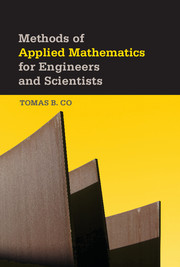Book contents
- Frontmatter
- Contents
- Preface
- I MATRIX THEORY
- III VECTORS AND TENSORS
- III ORDINARY DIFFERENTIAL EQUATIONS
- IV PARTIAL DIFFERENTIAL EQUATIONS
- 10 First-Order Partial Differential Equations and the Method of Characteristics
- 11 Linear Partial Differential Equations
- 12 Integral Transform Methods
- 13 Finite Difference Methods
- 14 Method of Finite Elements
- A Additional Details and Fortification for Chapter 1
- B Additional Details and Fortification for Chapter 2
- C Additional Details and Fortification for Chapter 3
- D Additional Details and Fortification for Chapter 4
- E Additional Details and Fortification for Chapter 5
- F Additional Details and Fortification for Chapter 6
- G Additional Details and Fortification for Chapter 7
- H Additional Details and Fortification for Chapter 8
- I Additional Details and Fortification for Chapter 9
- J Additional Details and Fortification for Chapter 10
- K Additional Details and Fortification for Chapter 11
- L Additional Details and Fortification for Chapter 12
- M Additional Details and Fortification for Chapter 13
- N Additional Details and Fortification for Chapter 14
- Bibliography
- Index
12 - Integral Transform Methods
from IV - PARTIAL DIFFERENTIAL EQUATIONS
Published online by Cambridge University Press: 05 April 2013
- Frontmatter
- Contents
- Preface
- I MATRIX THEORY
- III VECTORS AND TENSORS
- III ORDINARY DIFFERENTIAL EQUATIONS
- IV PARTIAL DIFFERENTIAL EQUATIONS
- 10 First-Order Partial Differential Equations and the Method of Characteristics
- 11 Linear Partial Differential Equations
- 12 Integral Transform Methods
- 13 Finite Difference Methods
- 14 Method of Finite Elements
- A Additional Details and Fortification for Chapter 1
- B Additional Details and Fortification for Chapter 2
- C Additional Details and Fortification for Chapter 3
- D Additional Details and Fortification for Chapter 4
- E Additional Details and Fortification for Chapter 5
- F Additional Details and Fortification for Chapter 6
- G Additional Details and Fortification for Chapter 7
- H Additional Details and Fortification for Chapter 8
- I Additional Details and Fortification for Chapter 9
- J Additional Details and Fortification for Chapter 10
- K Additional Details and Fortification for Chapter 11
- L Additional Details and Fortification for Chapter 12
- M Additional Details and Fortification for Chapter 13
- N Additional Details and Fortification for Chapter 14
- Bibliography
- Index
Summary
In this chapter, we discuss the integral transform methods for solving linear partial differential equations. Although there are several types of transforms available, the methods that are most often used are the Laplace transform methods and the Fourier transform methods. Basically, an integral transform is used to map the differential equation domain to another domain in which one of the dimensions is reduced from derivative operations to algebraic operations. This means that if we begin with an ordinary differential equation, the integral transform will map the equation to an algebraic equation (cf. Section 6.7). For a 2D problem, the integral transforms should map the partial differential equation to an ordinary differential equation, and so on.
We begin in Section 12.1 with a very brief introduction to general integral transforms. Then, in Section 12.2, we discuss the details of Fourier transforms, its definition, some particular examples, and then the properties. Surprisingly, the initial developments of Fourier transforms are unable to be applied to some of the most useful functions, including step function and sinusoidal functions. Although there were several ad hoc approaches to overcome these problems, it was not until the introduction of the theory of distributions that the various ad hoc approaches were unified and gained a solid mathematical grounding. This theory allows the extension of classical Fourier transform to handle the problematic functions.
Information
- Type
- Chapter
- Information
- Methods of Applied Mathematics for Engineers and Scientists , pp. 450 - 482Publisher: Cambridge University PressPrint publication year: 2013
